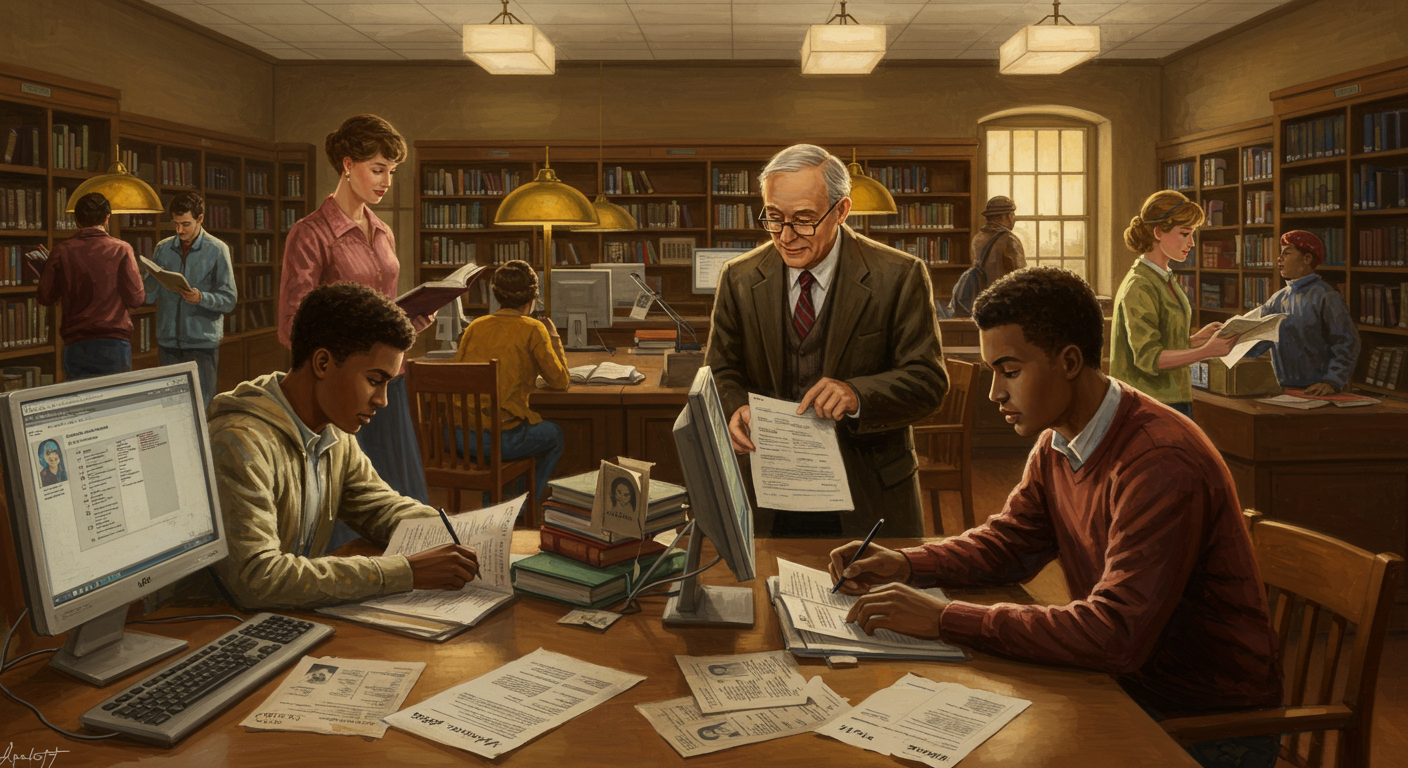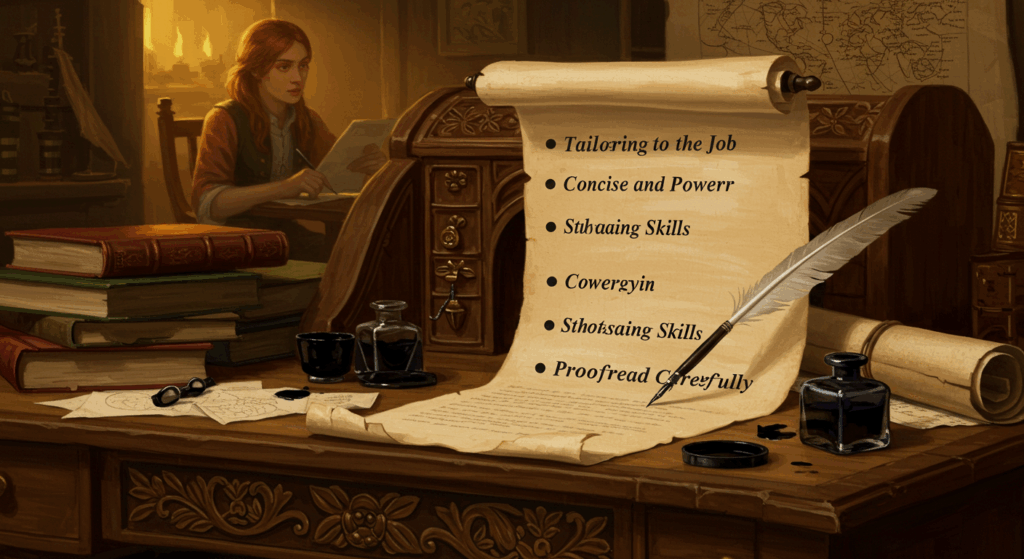Cover Letter Help: The Real Talk Guide You Wish You Had Sooner
We know that writing a cover letter can feel like trying to flirt on a dating app with zero prompts. “Describe yourself!” Um… I like dogs? And iced coffee? And… ugh. If your brain locks up the second you open a blank doc, you’re not alone. The vibe is: you know you’re qualified, but how do you say it without sounding like a robot or a try-hard? That’s where a little cover letter help (and yeah, sometimes full-on cover letter assistance) makes life easier.
I’m going to walk you through the whole thing—mindset to structure, language to layout, DIY tools to professional help—so you can stop doom-scrolling and actually hit submit with confidence. Think of this like a friend who’s read a ton of job posts (because I have, lol) and knows what hiring managers actually want. We’ll keep it conversational, yes slightly messy on purpose, and hyper-practical. Snack in hand? Spotify on? Cool, let’s go.
Why Cover Letters Still Matter (Even When Job Posts Say “Optional”)
So many job pages say, “Cover letter optional.” But “optional” is like that “maybe” text from someone you like—there’s definitely a path. A cover letter is your chance to:
- Add context your résumé can’t (career pivots, gaps, location changes).
- Show personality and culture fit (you’re a person, not a bullet list!).
- Connect your experience directly to the job’s top needs.
- Demonstrate communication skills (huge green flag).
Even if a recruiter skims—because yes, they’re busy—the right structure and keywords can make a fast, scannable case for you. And if the company cares about writing (marketing, operations, product, design, education, comms, customer roles), your letter becomes a mini work sample. No pressure. (Okay a lil pressure.)
The Mindset Shift: You’re Not “Begging,” You’re Offering
If writing a cover letter makes you feel like you’re pleading for a shot, flip it. You’re a product. The hiring team has a problem. You’re proposing solutions. Calm, direct, useful. Think “friendly consultant energy,” not “pick me choose me.” You’re not tring to tell your whole life story; you’re building a short, specific case for why you’ll help them hit their goals faster.
A good habit: each sentence should earn its keep. If it doesn’t help them visualize you solving a problem, delete, rephrase, or move it.
When to Get Cover Letter Assistance (And When You’re Fine DIY’ing It)
You can absolutely write this yourself. But sometimes getting cover letter assistance saves time and improves results, especially if any of these ring true:
- You’re pivoting industries or roles and can’t connect the dots.
- English isn’t your first language and you want a quick polish.
- You’ve been rejected a lot and don’t know what to fix.
- You’re targeting competitive roles (big tech, hot startups, NGOs, creative studios) where writing quality signals extra.
- You need help with strategy (what to highlight, what to skip), not just grammar.
If you want to stay DIY but still improve fast, ask for a cover letter review from a friend in your field, a mentor, or a career coach. Two or three specific notes from someone who “gets” the role can be game-changing. More on how to ask for feedback the right way in a sec.
The 5-Part Structure That Works (Without Feeling Like Mad Libs)
There’s no one true template, but this framework reads clean, skims well, and lets your personality show:
1) The Hello (2–3 lines)
- Address a person if you can. If not, “Hi Hiring Team” is fine.
- One-liner on the role and why you care.
- Quick alignment: something you admire about the company or a pain point you’re excited to help with.
“Hi Maya and team—As a lifecycle marketer who’s grown retention 18–32% across SaaS products, I’m excited about the Lifecycle Marketing Manager role at Streamly. Your push into community-led growth? That’s my jam.”
2) The Hook (3–4 lines)
- One punchy accomplishment or theme that screams “I do your top 1–2 things.”
- Make it specific, with numbers when possible.
“At Driftly, I rebuilt onboarding and reduced time-to-value from 14 to 6 days, then launched a milestone email series that lifted Day-30 activation by 21%. I’d love to bring that focus to Streamly’s freemium funnel.”
3) The Proof (one short paragraph or 3 bullets)
- 2–3 strongest achievements tied to the job description.
- Mirror their language lightly (don’t copy paste, just vibe).
- Keep each bullet to one sentence if possible.
- Led cross-functional experiment sprints (PM, Data, CS) to ship weekly; 3 out of 8 tests hit significance.
- Built lifecycle segmentation in Braze; drove 11% lift in upsell CTR with progressive profiling.
- Trained CS on cue-based prompts → 12% increase in NPS comments referencing “onboarding clarity.”
4) The Fit & Values (2–4 lines)
- Show culture fit authentically: teamwork style, bias to action, learning habit, or community involvement.
“I gravitate to hypothesis-driven teams and crisp docs. I care about accessible products and clear, kind feedback—my playbook is open by default.”
5) The Close (2–3 lines)
- Confident, warm, not needy.
“Thanks for reading—I’m excited to chat about how we can accelerate activation before Q4. I’ve attached a 1-page portfolio overview as well. Have a great week!”
That’s it. Quick, scannable, human.
Tailoring Without Burning Out (Reuse Smart)
You don’t need to write 100% from scratch every time. Create a “base letter” with your hook, 3 proof points, and signature. Then customize:
- Opening line: name the company and why you care (1–2 lines).
- 1–2 accomplishments: swap for the ones that match their JD most.
- Tools/keywords: reflect their stack lightly (Figma, HubSpot, SQL, Zendesk, Shopify, Braze—whatever’s relevant).
- Values sentence: pick something from their careers page or recent blog that resonates.
You’ll end up with a 60–70% reused core that still feels tailored and fresh.
Storytelling That Doesn’t Feel Cringe
Avoid the “ever since I was a child” arc unless it’s truly relevant. You want micro-stories tied to outcomes:
- Situation → Action → Result (+ metric).
- One or two clauses, max.
- Example: “We were losing trial users at Step 2. I shadowed support calls, found a password reset dead-end, and shipped a fix with Eng. Completion up 19% in a week.”
That’s a whole story in one sentence. Chef’s kiss.
Quantifying Your Impact (Even in “Soft” Roles)
Not every job is sales where the number is obvious. Still, you can quantify:
- Before/after: response time, defect rate, time-to-resolution, churn, activation, attendance.
- Scale: team size, budget managed, customers impacted, content reach.
- Speed: shipped 10 experiments/quarter, reduced onboarding from 4 weeks to 2.
- Quality: NPS, CSAT, app store rating changes, peer review scores.
Numbers help the reader trust you. If you don’t have perfect data, estimates (“~15%”) or ranges (“10–15%”) are okay—just be honest.
Tone: Professional but… You
“Professional” doesn’t mean stiff. You can keep it warm, clear, and human:
- Use everyday words (“helped,” “shipped,” “fixed,” “grew”).
- Drop corporate fluff: “synergistic,” “utilize,” “world-class.” Bleh.
- Avoid memes that might not land, but small asides are fine: “I like docs that make sense before coffee.”
- Emojis? Usually no, unless the brand is very playful (think social content roles at fun-forward companies).
Formatting Basics (Because Readability = Mercy)
- Length: 250–450 words is the sweet spot. Shorter if they ignore letters; longer if writing quality is central to the job.
- Font: standard sans serif or serif, 10.5–12pt.
- Margins: 1” or a hair smaller, consistent.
- File: PDF unless the application asks for a text box.
- Headers: Name, email, phone, LinkedIn/portfolio. Make sure links actually work (pls).
- White space: short paragraphs, bullets where helpful, no walls of text.
If you’re pasting into an online form, keep the structure but skip heavy styling. And always test paste—some forms eat your line breaks like popcorn.
Breaking Down Common Tricky Situations
1) Career Pivot
- Translate skills: “community management → customer success,” “teaching → learning design,” “biology research → data analysis.”
- Use a line like: “While my title was X, the core of my work was Y (what you’re applying to).”
- Lean hard on projects or volunteer work as proof.
2) Employment Gap
- Address briefly, confidently: “I took 8 months to care for family and completed a Google Data Analytics cert; I’m excited to bring fresh skills back to a team.”
- Then immediately pivot to value.
3) New Grad / Few Experiences
- Projects, internships, clubs, hackathons, case comps → all fair game.
- Focus on outcomes and collaboration: “Led a 4-person team to ship a prototype used by 2 campus orgs.”
- Energy matters: curiosity, shipping things, asking thoughtful questions.
4) Applying Internationally
- Mention work authorization if relevant.
- Address language briefly if it’s a strength: “Fluent in Indonesian and English—great for APAC partnerships.”
Getting Feedback: How to Ask for a Cover Letter Review
People love to help when you make it easy. If you’re asking a mentor or friend for a quick cover letter review, keep it tight:
- Give them the job posting link.
- Share your résumé + your draft (PDF or Google Doc).
- Ask 2–3 focused questions:
- “Is the hook strong for this JD?”
- “Which accomplishment feels least relevant—what would you swap?”
- “Any phrasing that reads stiff or unclear?”
And thank them. Always. A quick “Your note on the hook helped me land an interview!” update later? That’s how you build long-term career karma.
DIY vs Professional Help: What’s Worth Paying For (and What Isn’t)
There’s legit value in professional help—especially strategy-level support. What to look for:
- Industry fluency: They understand your field’s metrics and tools.
- Process: They ask about the job targets, then co-create a hook, not just “fix grammar.”
- Samples: You see work that reads human, not cookie-cutter.
- Boundaries: Clear revisions policy and timeline.
- Coaching vibe: You leave knowing how to customize next time.
What’s usually not worth it: ultra-generic “we’ll submit 50 applications for you” services. You get what you pay for, and spam rarely lands.
If you don’t want to pay, do a trade: you offer a skill (design polish, website tweak, copy editing) and a friend offers a cover letter review. DIY communism (jk, but kinda).
Keywords and ATS: Keep It Real
Yes, some systems parse text for relevance. But… don’t write for robots at the expense of clarity. Tips:
- Mirror 3–6 must-have phrases from the job description naturally.
- Use plain formatting; avoid text in images.
- Use standard section names (“Experience,” “Projects”).
- Don’t overstuff. Humans decide.
Your letter should still sound like you. If you read it out loud and it feels like you’re narrating a Siri shortcut, tone it down.
Examples You Can Remix (Short and Punchy)
1. Example A: Marketing
Hi Hiring Team,
I’m excited to apply for the Growth Marketer role at Lumen. I love how you’ve leaned into community-built content and I’d like to help scale it.
At Makerly, I rebuilt our SaaS onboarding to reduce time-to-value from 12 to 7 days and launched lifecycle campaigns that lifted Day-30 activation by 21%. I also led 8 experiment sprints with PM/Data/CS; 3 hit significance and drove a net 9% retention bump.
I’m happiest where docs are crisp, tests are constant, and customer insights lead. I care about accessible UX and write playbooks others can use.
Thanks for reading—would love to chat about accelerating activation before Q4.
—Name, LinkedIn, Portfolio
2. Example B: Customer Success (Career Pivot from Hospitality)
Hi Maya and team,
I’m applying for the Customer Success Associate role. I’ve spent 4 years leading front-of-house at a busy boutique hotel—coaching a 12-person team, resolving escalations, and lifting our monthly CSAT from 4.3 to 4.7.
While my title was hospitality, the core of my work was success: listening closely, clarifying outcomes, and following through. I introduced a simple “first-response script” that cut escalations by 18% and documented a playbook new hires used from day one.
I’m excited to bring that empathy and process focus to a product team.
—Name
3. Example C: New Grad Design
Hi Hiring Team,
I’m a product design grad who loves messy, ambiguous problems. In my capstone, I led research with 14 users and prototyped flows that cut task completion time by ~35%. I’m comfortable in Figma and can talk to engineers without crying (usually).
I’m drawn to your mission around accessible health and would love to help ship v1 features and learn fast with your team.
—Name, Portfolio
Use these as scaffolding. Don’t copy them verbatim (that’s boring). Plug in your details and voice.
“Cover Letter Assistance” Tools and Tactics That Actually Help
You don’t need a complex tech stack, but these moves make a difference:
- Your Base Library: Keep a Google Doc with your best 8–12 accomplishments in bullet form, each with a metric. When a job pops up, you can assemble quickly.
- Voice Check: Read your letter out loud. If you’re gasping for breath, split sentences. If it sounds like a corporate press release, put a real human word in there.
- Peer Swap: Find a buddy who’s also hunting and trade 15-minute reviews weekly.
- Professional Help: A one-time coaching session can help set your hook and fix blind spots. It’s less about grammar and more about positioning.
- Portfolio Add-Ons: If relevant, add a 1-page cheat sheet of key wins or links to your top 2 projects.
- Timebox: Give yourself 60–90 minutes per tailored letter. Perfectionism kills momentum; 80% good and submitted beats 100% “almost done” sitting in your drafts for 3 weeks (we’ve all been there, rip).
Mistakes I See All the Time (and How to Fix Them Fast)
- Starting with “To whom it may concern.”
Fix: “Hi Hiring Team,” or a name if you can find one. - Repeating your résumé line-by-line.
Fix: Pick 2–3 highlights and explain the why/how behind them. - Walls of text, no bullets.
Fix: One-sentence bullets for proof points; 2–4 lines per paragraph. - Clichés with no proof.
Fix: Replace “team player” with a one-liner story showing collaboration. - No ask.
Fix: End with a confident, clear close: “I’d love to chat about X.” - Forgetting the basics.
Fix: Check links, attach the correct file (lol), name it “Name-Role-CoverLetter.pdf.” - Over-formal or over-casual tone.
Fix: Aim for “friendly colleague,” not “Victorian lawyer” or “TikTok caption.”
Using Professional Help Without Losing Your Voice
Good professional help should amplify you, not overwrite you. If you hire someone:
- Give them samples of your writing so they can match tone.
- Be clear on target roles, stacks, and companies.
- Ask them to explain the strategy behind the hook they craft.
- Request an editable doc and a short “how to customize” note.
You want to leave knowing how to tailor future letters yourself. A solid pro isn’t trying to trap you into endless revisions; they’re trying to ship a strong draft and upskill you.
How to Measure If Your Cover Letter’s Working
- Interview rate: If you add letters and your interview rates rise, it’s working.
- Replies with notes: Recruiters referencing something specific from your letter = signal.
- A/B test: For a week, submit with letters to half your roles, without to half (similar quality jobs). Track results.
- Referrals: Sometimes a great letter convinces a warm contact to pass your application internally—nice cheat code.
Quick FAQ (Because Your Brain Is Tired)
How long should a cover letter be?
About 250–450 words. Short enough to skim, long enough to prove it.
Do people actually read them?
Some do deeply; many skim. But a good one can be the nudge from “maybe” to “interview.”
Should I use humor?
Light humor is fine. If you’re unsure, default to warm and clear.
Is “Dear Sir/Madam” okay?
It’s dated. Use “Hi Hiring Team” or a name.
PDF or doc?
PDF unless asked otherwise. If pasting into a form, keep clean text.
Multiple roles at the same company?
Try to pick one. If you must apply to two, tailor two distinct letters.
A Simple Checklist You Can Steal
- Personal greeting (or “Hi Hiring Team”).
- One-line why this company/role.
- Punchy hook that matches their top need.
- 2–3 proof points (numbers if you’ve got ’em).
- A sentence on values/culture fit.
- Clear, confident close with next step.
- Clean formatting, working links, correct file name.
- Read out loud once. Always catches something, like, always.
Where “Cover Letter Assistance” Fits Into Your Job-Search Flow
Think of cover letter assistance as a booster, not a crutch. Your flow could be:
- Target & Research (10–15 min)
Skim the JD, company site, recent updatyes. Write down 3 needs they clearly have. - Draft & Hook (30–45 min)
Build a hook that attacks need #1. Pick 2–3 proof points that match needs #2–3. - Cover Letter Review (15–20 min)
Ask a peer or a coach one or two surgical questions. Make changes. - Polish & Submit (10 min)
Final scan, links, file name, done. Reward yourself with Netflix or a walk outside (touch grass, besties).
If You Only Remember Three Things
- Specifics beat adjectives. “Grew activation 21%” > “strong growth mindset.”
- Tailoring doesn’t mean rewriting your soul. Swap the open, 1–2 proof points, and tools.
- Confidence + warmth wins. You’re not begging; you’re offering help.
Sample Lines You Can Copy-Paste (Then Edit)
- “I’m excited about the [Role] at [Company]—especially your push into [initiative/strategy]. I’ve helped teams solve similar challenges by [short tactic] and would love to bring that focus to your [team/mission].”
- “At [Previous Company], I led [project] that resulted in [outcome metric]. I partnered with [teams] to ship [thing] and documented a playbook others still use.”
- “While my title was [X], the core of my work was [Y]—the same muscle this role needs. That’s why I’m applying.”
- “I’m happiest in teams with crisp docs, quick experiments, and kind feedback. That’s the culture I see in your posts and job description.”
- “Thanks for reading—would love to chat about accelerating [goal] before [timeline].”
These are scaffolds. Swap in your content and voice.
Bringing It All Together (And Giving Yourself Some Grace)
If your last attempt at a cover letter looked like a high school essay intro—“Webster’s Dictionary defines marketing as…”—no shame. You’re learning. Most people were never taught how to write a modern, tight letter that actually feels like them. That’s why cover letter assistance exists: to help you find the sharp, true version of your story and put it on one page without crying into your keyboard at 1 a.m.
The combo that works, ngl, is simple:
- A clear hook tied to their biggest need.
- Two or three proof points with numbers.
- A calm, friendly tone that sounds like you.
- A quick cover letter review to catch blind spots.
- Consistency—submit consistently and improve in tiny steps.
And if you want professional help, cool. Just make sure the person is helping you become stronger, not just slapping a shiny coat of paint on generic sentences. Your voice matters and your wins matter. Your weird career path? That might be your superpower, actually.
You’ve got this. Put on your focus playlist, set a 60-minute timer, write the imperfect first draft, and then polish it just enough to be proud. Then send it. The job search is a numbers game, sure—but it’s also a story game. And now you know how to tell yours.
Ready to ship a better letter? Open a fresh doc, write your hook in two lines, and ask one friend for a quick review today. Future-you (and your inbox) will be very, very happy.









